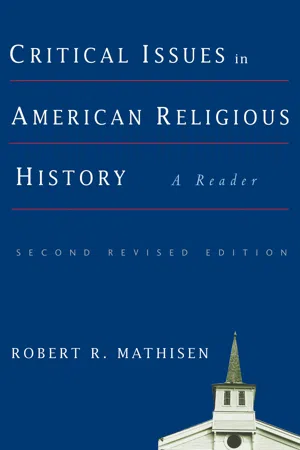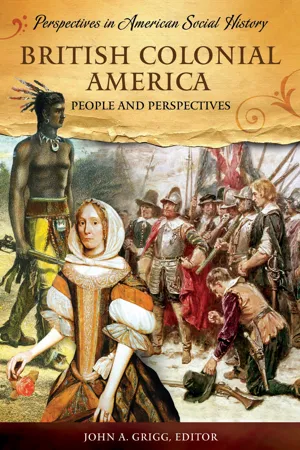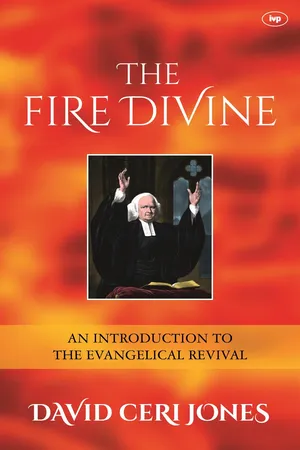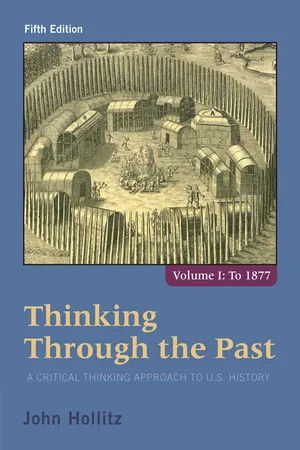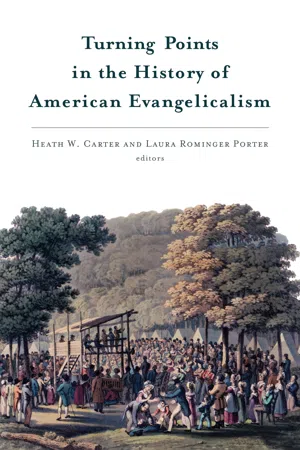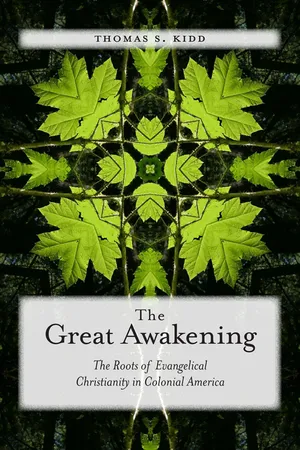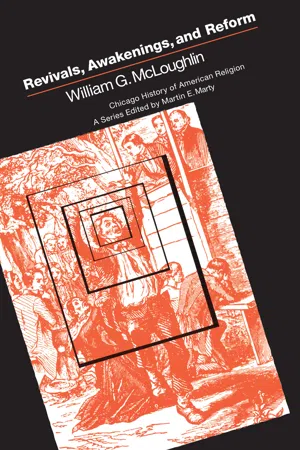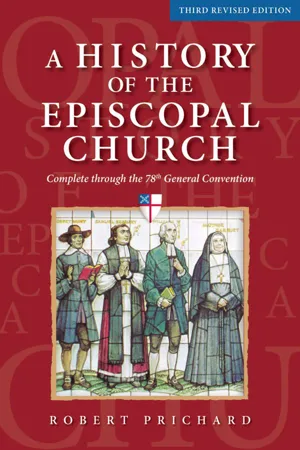History
The Great Awakening
The Great Awakening was a religious revival movement that swept through the American colonies in the 1730s and 1740s. It emphasized a personal connection with God and challenged traditional religious authority, leading to the rise of new denominations and a greater emphasis on individual spiritual experience. The movement had a significant impact on American society, politics, and culture.
Written by Perlego with AI-assistance
Related key terms
1 of 5
12 Key excerpts on "The Great Awakening"
- eBook - PDF
God's Democracy
American Religion after September 11
- Emilio Gentile(Author)
- 2008(Publication Date)
- Praeger(Publisher)
It was, however, a personal type of religion, an individual type, emotional more than doctrinal; often it did not belong to the traditional confes- sions and institutional places of worship, and so it corresponded to the growing diversity of American religions, making the changing pattern of a new religious America so unique. 39 Impressed by the sudden growth in church attendance and intensified devout- ness in America following September 11, the most important exponents of tradi- tional and fundamentalist evangelicalism stated triumphantly that America was The Great Awakening 109 more religious once again. Jerry Falwell predicted that the Americans were about to devote themselves to God at long last, and Pat Robertson announced that there was occurring one of the greatest spiritual awakenings in the history of America. 40 The general American phrase “Great Awakening” indicates the Protestant evangelical movements, born of a renewed faith and religious enthusiasm, to preach individual and collective moral regeneration through a more rigorous observance of the Scriptures in private and public life. In the history of America these movements had preceded and influenced decisive changes in politics. The first Great Awakening, in the mid-eighteenth century, had prepared the structure of American patriotism on the eve of the War of Independence; a second Great Awakening which developed during the early decades of the nineteenth century had accentuated the evangelical nature of American Protestantism and its democ- ratization, and it contributed to America’s westward expansion with its missionary ardor to evangelize; at the end of the nineteenth century there was talk of a Third Awakening with the spread of millenarian movements. During the last 10 years of the twentieth century, theologians and clergymen thought that America was about to experience another Great Awakening. - eBook - PDF
Critical Issues in American Religious History
A Reader, Second Revised Edition
- Robert R. Mathisen(Author)
- 2006(Publication Date)
- Baylor University Press(Publisher)
85 Few events in American history have produced so many conflicting percep-tions and seemingly irreconcilable interpretations as the series of religious revivals in the late 1730s and early 1740s known as The Great Awakening. To revivalists like Jonathan Edwards, the Awakening was “an extraordinary and mighty Work of God’s Special Grace.” Its fruits included the transformation of society and the saving of individual souls. “When once the Spirit of God began to be so wonderfully poured out in a general way through the Town [Northampton],” he wrote, “People had soon done with their old Quarrels, Backbitings, and Intermeddling with other men’s Matters.” Among Edwards’s antagonists, however, the Awakening was some-thing quite different—a confusion that produced “enthusiastic Heat” and “Commotion in the Passions.” Not only did it fail to reform hearts and minds, but, wrote Charles Chauncy, a Boston cleric, “Tis not evident to me that Persons . . . have a better Understanding of Religion, a better Government of their Passions, a more Christian love to their Neighbour, or that they are more decent and regular in their Devotions toward God.” For all the verbal sparring between Edwards, Chauncy, and many clergy and laypersons of their time, more recently the larger question has been raised as to the historical reality of the phenomenon now labeled “The Great Awakening.” In 1982, Jon Butler caught the attention of colonial historians with his suggestion that the Awakening was an “interpretive fiction,” con-ceived by the minister-scholar Joseph Tracy, who first used the term “Great Awakening” in his 1841 publication by that title. Tracy produced his work, Butler contends, to support America’s nineteenth-century revivals, particu-larly the “Second Awakening” then in process. Chapter 3 The Era of The Great Awakening Issue: What was the meaning of The Great Awakening? d - eBook - PDF
British Colonial America
People and Perspectives
- John A. Grigg(Author)
- 2008(Publication Date)
- ABC-CLIO(Publisher)
Separates recruited New Lights to become settled ministers in new churches, while others managed to expel established ministers to be replaced by men they deemed more suitable. The Great Awakening was a massive wave of evangelical Christian fervor that swept through the American colonies during the mid-18th century. Some believers marched in singing processions, like this one depicted in 1740. (North Wind Picture Archives) C H A P T E R 9 175 T H E G R E AT AWA K E N I N G A M O N G C O M M O N P E O P L E Women Play a Key Role in the Awakening A rising tide of antiauthoritarianism implicit in more radical New Light rhet- oric encouraged those who chafed at traditional hierarchies to challenge them, to contest established boundaries, resulting in new definitions of au- thority. Among ordinary people, nowhere was this more in evidence than among women. At a time when female church membership and attendance already outpaced that of men, the First Great Awakening opened new doors to female religious self-assertion and authority. Arising out of the intense emotionalism of Calvinist conversion experi- ences and the intimacy between the individual soul and God, revivalism emphasized emotional intensity rather than intellectual assent in religion. By 1700, women made up the vast majority of church members because of societal and economic factors that saw male church membership and religi- osity decline throughout the colonies. Women came to fill gaps in church management and religious instruction when their domestic duties permit- ted, much as they did in their homes at times when husbands and fathers were preoccupied with work or business. Consequently, women were among the first and most ardent respondents to revivalism, even if most New Light ministers opposed any recognition of female authority beyond the informal. Women had to walk a thin line between patriarchy and their newfound respectability and power. - eBook - ePub
- Perry Miller(Author)
- 1956(Publication Date)
- Belknap Press(Publisher)
Once this international viewpoint is assumed, the American outburst becomes merely one among many — a colonial one at that — and we hesitate to speak about it as a crisis in a history specifically American. What was at work throughout the Western world is fairly obvious: the upper or the educated classes were tired of the religious squabbling of the seventeenth century, and turned to the more pleasing and not at all contentious generalities of eighteenth-century rationalism; the spiritual hungers of the lower classes or of what, for shorthand purposes, we may call “ordinary” folk were not satisfied by Newtonian demonstrations that design in the universe proved the existence of God. Their aspirations finally found vent in the revivals, and in each country we may date the end of a Calvinist or scholastic or, in short, a theological era by the appearance of these movements, and thereupon mark what is by now called the era of Pietism or Evangelicalism.In this frame of reference, The Great Awakening was only incidentally American. It is merely necessary to translate the European language into the local terminology to have an adequate account. In this phraseology, The Great Awakening in New England was an uprising of the common people who declared that what Harvard and Yale graduates were teaching was too academic. This sort of rebellion has subsequently proved so continuous that one can hardly speak of it as a crisis. It is rather a chronic state of affairs. And in this view of it, the uprising of 1740 belongs to the international history of the eighteenth century rather than to any account of forces at work only on this continent.Told in this way, the story will be perfectly true. Because we talk so much today of the unity of Western European culture, maybe we ought to tell it in these terms, and then stop. But on the other hand there is a curiously double aspect to the business. If we forget about Germany and Holland and even England — if we examine in detail the local history of Virginia, Pennsylvania, and New England — we will find that a coherent narrative can be constructed out of the cultural developments in each particular area. This Awakening can be seen as the culmination of factors long at work in each society, and as constituting, in that sense, a veritable crisis in the indigenous civilization. - eBook - ePub
The Fire Divine
An Introduction To The Evangelical Revival
- David Jones, David Ceri Jones(Authors)
- 2015(Publication Date)
- IVP(Publisher)
4 ‘All the world is growing religious’: The Great Awakening in America
The revival that had shaken Northampton, Massachusetts, in 1734–5, and that had been such an important catalyst for awakenings elsewhere, especially following the publication of Jonathan Edwards’s A Faithful Narrative of the Surprising Work of God in America in 1736 and Britain in 1737, did not lead to a wider religious revival in the American colonies – at least not immediately. It was not until George Whitefield arrived in the colonies for the second time that a more extensive revival was sparked into life. Sustaining an itinerant preaching schedule that covered the whole of the American colonies, Whitefield travelled 1,300 miles from the New England colonies in the north to Georgia in the south. In the process he drew together all those who had already led localized revival movements, individuals such as Gilbert Tennent in Pennsylvania and Theodorus Frelinghuysen in New Jersey, into an intercolonial evangelical movement that some soon began to call a ‘Great Awakening’. Whitefield’s ministry inspired rapid growth in most of the Protestant denominations in the colonies during the middle decades of the eighteenth century. While the revivals could be a disruptive force, shattering the religious cohesion of many colonial societies, they were also simultaneously a unifying force. They drew together the disparate thirteen colonies at broadly the same time as some were beginning to see their future as being free of British control.George Whitefield and the creation of a ‘Great Awakening’
Whitefield stepped foot on American soil at the end of October 1739; over the course of the following fifteen months he set the colonies ablaze with his itinerant preaching. There were three main preaching tours during these months, interspersed with shorter itineraries, and extended periods in Georgia, where Whitefield oversaw the establishment of his orphanage, ostensibly the main reason for his presence in America. Expectations had been building about Whitefield’s arrival for some time: prominent colonial newspapers such as The Pennsylvania Gazette and the American Mercury Weekly - eBook - PDF
Thinking Through the Past
A Critical Thinking Approach to U.S. History, Volume 1
- John Hollitz(Author)
- 2014(Publication Date)
- Cengage Learning EMEA(Publisher)
Copyright 2014 Cengage Learning. All Rights Reserved. May not be copied, scanned, or duplicated, in whole or in part. Due to electronic rights, some third party content may be suppressed from the eBook and/or eChapter(s). Editorial Review has deemed that any suppressed content does not materially affect the overall learning experience. Cengage Learning reserves the right to remove additional content at any time if subsequent rights restrictions require it. SecondarySource 151 people, especially the poor, compelling visions of individual self-respect and collective self-confidence. Like the Populist movement at the end of the nineteenth century, these movements took shape around magnetic leaders who were highly skilled in communication and group mobilization. Abstractions and generalities about the Second Great Awakening as a con-servative force have obscured the egalitarianism powerfully at work in the new nation. As common people became significant actors on the religious scene, there was increasing confusion and angry debate over the purpose and function of the church. A style of religious leadership that the public deemed “untutored” and “irregular” as late as the First Great Awakening became overwhelmingly successful, even normative, in the first decades of the republic. Ministers from different classes vied with each other to serve as divine spokesmen. Democratic or populist leaders associated virtue with ordinary people and exalted the vernacular in word, print, and song. . . . The American Revolution is the most crucial event in American history. The generation overshadowed by it . . . stands at the fault line that sepa-rates an older world, premised on standards of deference, patronage, and ordered succession, from a newer one that continues to shape our values. The American Revolution and the beliefs flowing from it created a cultural ferment over the meaning of freedom. Turmoil swirled around the crucial issues of authority, organization, and leadership. - Karen J. Johnson, Jonathan M. Yeager, Karen J. Johnson, Jonathan M. Yeager(Authors)
- 2024(Publication Date)
- University of Wisconsin Press(Publisher)
4 (1968): 243–53; Ross W. Beales Jr., ed., “Solomon Prentice’s Narrative of The Great Awakening,” Proceedings of the Mas- sachusetts Historical Society 83 (1971): 135. 2. See John Howard Smith, The First Great Awakening: Redefining Religion in British America, 1725–1775 (Madison, NJ: Fairleigh Dickinson University Press, 2015), 137–40, 149–69. 3. A typical example of the way textbooks characterize the Awakening is found in James L. Roark, Michael P. Johnson, Patricia Cline Cohen, Sarah Stage, and Susan M. Hartman, The American Promise: A History of the United States, 7th value ed. (Boston: Bedford/St. Martin’s, 2017): “Colonial revivals expressed in religious terms many of the same democratic and egalitarian values expressed in economic terms by colonists’ patterns of consumption. . . . Like consump- tion, revivals contributed to a set of common experiences that bridged colonial divides of faith, region, class, and status” (117). For a detailed historiographic survey of the Awakening, see Smith, The First Great Awakening, 3–7. Major cor- rectives to faulty chronologies and interpretations of the Awakening include Smith, The First Great Awakening; and Douglas L. Winiarski, Darkness Falls on the Land of Light: Experiencing Religious Awakenings in Eighteenth-Century New England (Chapel Hill: University of North Carolina Press, 2017). 4. Jonathan Edwards to George Whitefield, February 12, 1739/40, in The Works of Jonathan Edwards, Jonathan Edwards Center, Yale University, http://edwards .yale.edu/archive?path=aHR0cDovL2Vkd2FyZHMueWFsZS5lZHUvY2dpL WJpbi9uZXdwaGlsby9nZXRvYmplY3QucGw/Yy4xNTo1OjIyLndqZW8=; Ezra Stiles, Discourse on the Christian Union (Boston, 1761), 50. On covenant renewals, see Michael J. Crawford, Seasons of Grace: New England’s Revival Tradition in Its British Context (New York: Oxford University Press, 1991), 43–45.- Available until 27 Jan |Learn more
Conflict, Conquest, and Conversion
Two Thousand Years of Christian Missions in the Middle East
- Eleanor H. Tejirian, Reeva Spector Simon(Authors)
- 2012(Publication Date)
- Columbia University Press(Publisher)
FOUR The Great Awakening of the Protestants and the AnglicansW illiam Blake’s famous lines written in 1804 tell us much about the development of the missionary impulse in Britain in the eighteenth century:I will not cease from Mental FightNor shall my Sword sleep in my hand:Till we have built Jerusalem,In England’s green & pleasant Land.As with the Crusades, there was an emphasis on conquest by the sword, on the centrality of Jerusalem, and now on the identification of England with Jerusalem—the millenarianism that marked the eighteenth and nineteenth centuries. Imperialism joined with the new ideas of the Enlightenment to inspire The Great Awakening in the mid-eighteenth century. Beginning with the preaching and writing of Reverend Jonathan Edwards in New England, the reform ideas spread to Britain, emphasizing the need to bring the whole world to Christianity. Revival movements on both sides of the Atlantic were directed toward what members saw as moribund church institutions. In the next three chapters, we consider the growth of foreign missions to the Middle East from the United States and Europe from 1798 to 1914 in their political and intellectual context.By the early eighteenth century, Calvin’s ideas of election and predestination, which had been a deterrent to early missionary activity, were becoming less popular and being replaced by the view of Dutch theologian Jacob Arminius (1560–1609) that individual conversion, not predestination, determined salvation. This meant that faith could not only be shared, but spread abroad.1 Several dissenting groups, all of which stressed personal religious experience, Christian fellowship, and individual interpretation of scripture, coalesced into what became known as “Pietism,” a reform movement within late-seventeenth-century German Lutheranism based on the teachings and writings of Philipp Jakob Spener (1635–1705). Pietist institutions were founded in Halle, Germany. They included an orphanage and a university that trained missionaries. The movement gradually spread throughout central and northern Germany until Spener’s death in 1705, when the movement declined. In 1727, however, Spener’s godson Count Nicholas Ludwig von Zinzendorf revived the movement as the Moravian Church. Based on his estate at Herrnhut in Saxony, the Moravians developed the concept of the whole church as missionary church, and in the 1730s they began sending out missionaries to the West Indies, Greenland, Surinam, South Africa, the Gold Coast, and Ceylon.2 The Moravians focused their attention on salvation of the individual soul, especially the “First Fruit”—the “most wretched heathen of them all” or “those whom nobody else would dare to approach.”3 Not limited to Moravians, Pietist influence extended to Puritans in New England, Presbyterians in Scotland, and the Methodists and Baptists in England.4 - Heath W. Carter, Laura Porter(Authors)
- 2017(Publication Date)
- Eerdmans(Publisher)
CHAPTER 1 What Made The Great Awakening Great? Harry S. StoutWhat made The Great Awakening great? It is a question that first pressed upon me after reading my colleague Jon Butler’s brilliant and provocative article “Enthusiasm Described and Decried: The Great Awakening as Interpretive Fiction.”1 In that article, Butler argued that nothing novel or revolutionary occurred around 1740 making for a “Great Awakening.” Rather, the “Great Awakening” was a pseudo-event invented by historians. While much of what Butler argued is plausible, I propose that something “great” did indeed happen around 1740, and the chief protagonists were George Whitefield and Jonathan Edwards. In making the case for a truly great awakening in the middle of the eighteenth century, I do not intend to follow the path of earlier church historians whose explanations focused on theology and church history. Left unexplored in these earlier filiopietistic accounts is the question of religious innovations on the level of rhetoric and communications embodied by Whitefield. Also left out for the most part is the question of overlaps between The Great Awakening and the “New Learning” associated with the Enlightenment, where Edwards is the chief exemplar. In their own ways, each of these luminaries contributed something unique and revolutionary to their inherited faith.First The Great Awakening as a revolution in rhetoric and communications: on August 14, 1739, the famed itinerant George Whitefield embarked on a preaching tour of colonial America after enjoying a superstar’s success in his native England. Soon Americans would get their first exposure to the open-air preacher, and their churches would never be the same. Audiences numbering in the thousands appeared seemingly out of nowhere to hear the “Grand Itinerant” preach the gospel in new and exciting ways. With Whitefield’s preaching tour, a new pulpit rhetoric emerged that would redefine preaching and lead to the rise of a novel form of Protestantism we identify today with “evangelicalism.” Historian Perry Miller described this new rhetoric as “the rhetoric of sensation.”2- eBook - PDF
The Great Awakening
The Roots of Evangelical Christianity in Colonial America
- Thomas S. Kidd(Author)
- 2008(Publication Date)
- Yale University Press(Publisher)
During the excitement of the early 1740s, some New En-glanders imagined that the revivals might signal the imminent coming of the kingdom of God. With the coming of King George’s War (1744–48) and the at-tack on Louisbourg in 1745, millennial readings of current events shifted back to the fortunes of the British Empire at war with French and Spanish Catholicism. New England saw comparatively few revivals during the 1750s, and the colonial South became the chief scene of revivalist activity.2 Starting in 1762, however, a “There Is Really a Great Awakening” number of New England’s formerly radical evangelical churches witnessed an-other round of awakenings. Personal correspondence networks, especially those coordinated by Isaac Backus and Eleazar Wheelock, distributed news of revival with the hope that the work of God would spread. Former radical leaders like Cleaveland and Samuel Buell used printed narratives to paint these new revi-vals as the successors to the triumphs of the 1740s, even as they continued to promote enthusiastic manifestations and separation from corrupt churches as reasonable responses to the Spirit. These leaders saw the revivals of the 1760s as recurrences of the Spirit’s outpourings in the 1740s. In their narratives, the leaders transformed the local practice of revivals into public appeals for the rights of individual conscience and reasonable enthusi-asm. Narrating revivals became a tool for legitimizing radical evangelicalism. In their printed accounts of the 1760s revivals, one sees the maturation of radicals who tried to establish their definition of the evangelical movement in the Anglo-American public sphere. The practical experiences of the 1760s revivals helped the former radicals articulate two key tenets of the revolutionary age: the free-dom of private judgment, and the liberty to separate from established powers. - eBook - ePub
- William G. McLoughlin(Author)
- 2013(Publication Date)
- University of Chicago Press(Publisher)
It is significant that the new-light revivalists throughout the awakening found that their liberating theology had a profound effect upon the powerless and the poor of society—upon black slaves, upon women, upon Indians, upon children. These suffered more tensions and suppressed rage than most in society and felt the release of conversion (the reaction formation) more deeply. They could not, however, actualize the new freedom and power they felt except in religious activity—in preaching, saving souls, becoming missionaries (or missionaries’ wives). Yet even this form of sublimated freedom produced a surprising number of black, Indian, and women preachers and exhorters in the years after 1740. Heimert has argued persuasively that in the First Great Awakening, God was democratized.Revitalization of the individual led to efforts to revitalize society. Having a new sense of harmony with God, the new-light convert was impelled to work in conjunction with God’s power to help his fellow men have it likewise. The regenerate could not rest content with the world as it was; they wished to make it what it ought to be. Where the old lights saw human progress as slow and gradual, limited by hereditary and environmental contingencies, the new light found the world open to the miraculous—unconditioned, full of new possibilities and unrealized potentials. Religious revivalism, saving souls, is in this respect a political activity, a way of producing a reborn majority to remodel society according to God’s will and with his help. Despite Edwards’ arguments against freedom of the will, despite the continued belief in man’s innate depravity and God’s predestined election, the awakening raised hopes that the whole continent might be converted. God might have elected all Americans to sainthood.Although millennialism in various forms had been prevalent during the Puritan Awakening, the majority of those who came to America had adopted a premillennial interpretation; namely, that God would have to send Christ back a second time to bring order to the world. Increase Mather, appalled at the barbarism of the frontier and the provincialism of the colonies, concluded that “in the glorious times promised to the Church on Earth, America will be Hell.” Eighteenth-century rationalists, though slightly more optimistic about progress because of advances in scientific knowledge, nevertheless were cautious about it and clung to the classical view that history moves in cycles. The British Empire might be in its ascendancy at the moment, but, like Greece and Rome, it too would fall in time. Unitarians like John Adams and deistic Episcopalians like Thomas Jefferson held to this cyclical view even for the United States of America. - eBook - ePub
A History of the Episcopal Church - Third Revised Edition
Complete through the 78th General Convention
- Robert W. Prichard(Author)
- 2014(Publication Date)
- Morehouse Publishing(Publisher)
48The Effects of the AwakeningThe Great Awakening changed the theological character of the colonial Church of England. While advocates of awakening of the 1760s and 1770s never did abandon episcopal succession or the fixed liturgy in the way that Whitefield had been willing to do in 1739, they did adopt sentimentalist styles of preaching and Whitefield’s call for adult conversion. Even critics of the Awakening began to pay greater attention to personal religious experience. The attempt to integrate this new appreciation for affections with the received covenant tradition would, in turn, be a major topic of interest for theologians at the end of the century.Changes were not only theological, however. Indeed, there were few aspects of church life that were left untouched. The membership, the institutions, and even the architecture and church music of the denomination were affected.The MembershipOne way in which The Great Awakening changed the membership was by subtly raising the status of women. Female literacy was considerably lower than male literacy in the eighteenth century; by some estimates it was one-half that of men.49 The intellectual religion of the Moderate Enlightenment had, therefore, limited appeal to women. The Awakening, however, with its emphasis on affections and its household prayer meetings, provided new opportunities for female involvement. Martha Laurens Ramsay (1759–1811), the daughter of a prominent South Carolina family that attended St. Philip’s Church in Charleston, found, for example, that her awakened faith opened doors to a world with greater possibilities. She corresponded with such pious Englishwomen as Selina, Countess of Huntingdon (1707–91) and began a personal religious journal, which was published by her husband after her death.50
Index pages curate the most relevant extracts from our library of academic textbooks. They’ve been created using an in-house natural language model (NLM), each adding context and meaning to key research topics.

